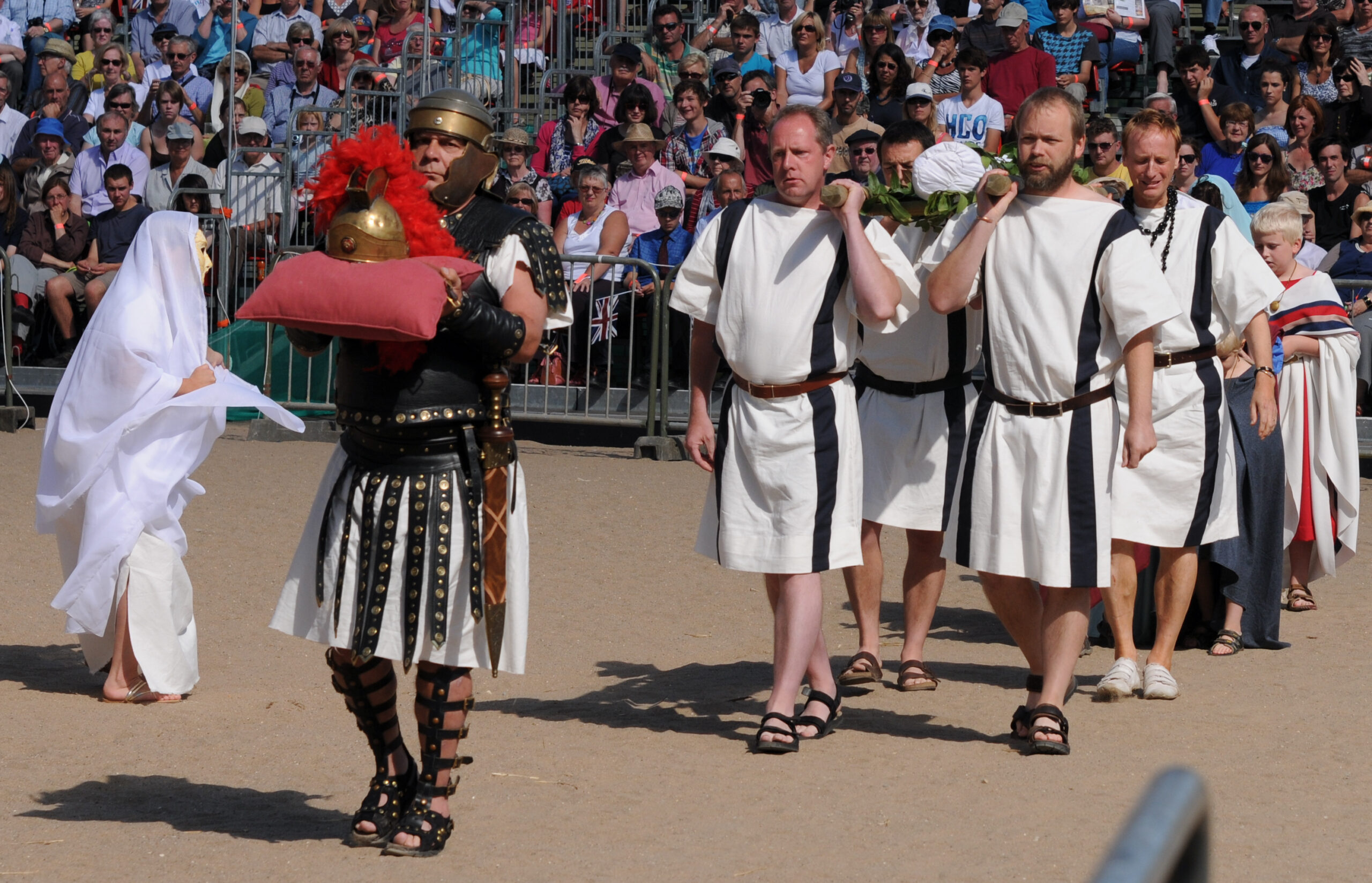By Harry Mottram: Axbridge is first recorded in the early 10th century in the Burgal Hideage of Saxon Britain and we know coins were minted here in 977. But what was here before that? Well with a little imagination we start the known history in the mists of Roman Britain when Axbridge contained a farm, perhaps a hamlet and even a graveyard. And before that the area was the hunting grounds of Celts who had replaced earlier inhabitants who lived in the area since the end of the Ice Age.
Roman pottery and ditches have been discovered and a Romano British body neatly buried near the school in Old Church Road. We conjure up a scene depicting the moment when Roman tradition meets Celtic mysticism.
In previous pageants the Romans were depicted as slave drivers – whipping the down-trodden Celts as they carried the lead from the Mendips off to the cities of the Roman Empire. Whether it was the images of Roman domination as depicted in the 1959 movie Ben Hur directed by William Wyler, and starring Charlton Heston that inspired Chris Cowap’s script or the chance of some sado-macochistic drama at the start of the pageant – we can only speculate.

The Romans left as rulers of Britain as the Empire imploded and following their departure the Britains reverted to a previous way of life with hill forts and wattle and daub homes.
When the Saxons moved in to merge with the locals a new era began in Somerset.
And so to the creation of the town in the early 9th century by Anglo Saxons as a fortified settlement or Burh to resist the Danes who got as close as Tarnock – just down the A38.
Axanbrycg’s name (as it was known) is thought to have been coined as a bridge over a river – possibly the one that flows under the Square rather than the River Axe in the marshes below the town.
Where the first town was located is open to conjecture but just off the Square is the generally accepted thinking. Axanbrycg was important with its own mint making silver coins and as a base for King Alfred’s campaigns against the Danish army.
To this we have our next scene in which the Saxon army battles it out in a home win against the invaders. Just think, if the Danes had won then we’d have become Scandinavians and Danish would have been the language of Australia and Canada – and we’d have exported Ikea stores to the world instead of sofas from John Lewis.
Back to Saxon Axbridge. Cue the Danish army and the battle (as recorded in the Anglo Saxon Chronicle) of The Raven. Nobody is quite sure where the brutal struggle took place, so in this version we consider that Axbridge is the most likely site for the Dark Age dust up.

Let the Chronicler take up the story: “M’æst winterstund onufan lang twelfta, wægn fyrdtruma tô−foran sê lendan.”
Or in our modern tongue: “In the year AD 878 about mid-winter after Twelfth Night, the Danish Army rode out over the land of the West Saxons and drove many people into the sea and of the rest most part they rode down and subdued their will.
“But King Alfred with a little band uneasily sought the woods and fastnesses of the moor with the war flag they called The Raven.
“In the seventh week after Easter, the King and his little force fought all the Danish army and put them to flight riding after them up to their fortress.
“There the Danes gave him hostages with many oaths, that they would go out of his kingdom. They told him also, that their king would receive baptism.”
In 927AD England finally emerged as a nation under King Æthelstan and despite various bust ups between the rulers Axbridge was an Anglo Saxon domain.
Christianity had taken a foothold during the Roman era but by the time Axbridge was established by the Saxons it had largely replaced the old religions and was to play an important role in the town.
Axbridge News is edited by Harry Mottram and is published for the interest of himself and fellow residents
Harry is a freelance journalist. Follow him on Facebook, LinkedIn, Twitter, Instagram, YouTube etc
Email:harryfmottram@gmail.com
Website:www.harrymottram.co.uk
Mobile: 07789 864769


You must be logged in to post a comment.